In addition to checking out some of the sensational books that have pirouetted onto our shelves this week, beloved patrons, we also wanted to bring you some information about hurricane relief efforts. Our neighbors and friends in North Carolina, South Carolina, and the mid-Atlantic region in general are still suffering the effects of Hurricane Florence, and they need our help. While the extent of the damage–and, hence, the extent of the need–is not yet fully known, there are several ways in which you can provide immediate help.

First and foremost, the American Red Cross has set up a website devoted specifically to donations for hurricane relief. You can also make donations over the phone by calling 1-800-RED CROSS (1-800-733-2767) or texting “FLORENCE” to 90999. When calling or donating online, make sure to designate your donation to Florence relief efforts.
In addition, the Red Cross is also asking for blood donations, which can be made locally. Check the Red Cross website to find the closest donation location to you.
The Food Bank of Central and Eastern North Carolina has been active in dozens of communities in North and South Carolina for more than 35 years, and is working hard to provide food, water, hygiene items, and cleaning supplies to the thousands affected by the hurricane. While we can’t really send them food, there is a virtual food drive that remains ongoing, in which you can participate. Additionally, monetary donations are appreciated.
In South Carolina, the One SC Fund works to support the state by funding nonprofits with grants during state-declared emergencies. For Tropical Depression Florence relief, the One SC Fund is accepting donations online. The Fund states these donations will support other nonprofits “that are, and will be, responding to the needs of individuals affected by Hurricane Florence.”
In North Carolina, the North Carolina Disaster Relief Fund is currently accepting contributions for Hurricane Florence damage. Contributions will help with immediate unmet needs of Hurricane Florence victims. Contributions can be made online by secure link, or you can text “Florence” to 20222. Alternatively, checks can be mailed to:
North Carolina Disaster Relief Fund
20312 Mail Service Center
Raleigh, NC 27699
As always, if you are not able to donate at this time, please do not worry. There will always be ways to help, and any contributions you can make at any time will be appreciated. And thank you in advance for your good will and kindness!
And now…on to the books!

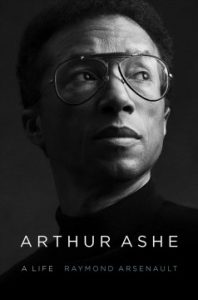 Arthur Ashe: A Life:Born in Richmond, Virginia, in 1943, by the age of eleven, Arthur Ashe was one of the state’s most talented black tennis players. Jim Crow restrictions barred Ashe from competing with whites. Still, in 1960 he won the National Junior Indoor singles title, which led to a tennis scholarship at UCLA. He became the first African American to play for the US Davis Cup team in 1963, and two years later he won the NCAA singles championship. In 1968, he won both the US Amateur title and the first US Open title, rising to a number one national ranking. Turning professional in 1969, he soon became one of the world’s most successful tennis stars, winning the Australian Open in 1970 and Wimbledon in 1975. After retiring in 1980, he served four years as the US Davis Cup captain and was inducted into the International Tennis Hall of Fame in 1985. In this fascinating biography, Raymond Arsenault chronicles Ashe’s rise to stardom on the court, as well as his off-court career as a writing, historian of tennis, and human rights activist in the United States, as well as an advocate for the destruction of Apartheid policies in South Africa. Additionally, Arsenault takes us through Ashe’s heart condition, which led to multiple surgeries and blood transfusions, one of which left him HIV-positive. In 1988, after completing a three-volume history of African-American athletes, he was diagnosed with AIDS, a condition he revealed only four years later. After devoting the last ten months of his life to AIDS activism, he died in February 1993 at the age of forty-nine, leaving an inspiring legacy of dignity, integrity, and active citizenship. This is an important, overdue, and highly enjoyable biography that is being praised by readers, critics, and tennis players, as well! The New York Times Review of Books gave it a resoundingly positive review, saying “For those who have long admired Ashe, this close look at his life offers even more evidence that he was more than a great player, he was an extraordinary person. . . . among the best books about tennis I’ve ever read — it’s a deep, detailed, thoughtful chronicle of one of the country’s best and most important players.”
Arthur Ashe: A Life:Born in Richmond, Virginia, in 1943, by the age of eleven, Arthur Ashe was one of the state’s most talented black tennis players. Jim Crow restrictions barred Ashe from competing with whites. Still, in 1960 he won the National Junior Indoor singles title, which led to a tennis scholarship at UCLA. He became the first African American to play for the US Davis Cup team in 1963, and two years later he won the NCAA singles championship. In 1968, he won both the US Amateur title and the first US Open title, rising to a number one national ranking. Turning professional in 1969, he soon became one of the world’s most successful tennis stars, winning the Australian Open in 1970 and Wimbledon in 1975. After retiring in 1980, he served four years as the US Davis Cup captain and was inducted into the International Tennis Hall of Fame in 1985. In this fascinating biography, Raymond Arsenault chronicles Ashe’s rise to stardom on the court, as well as his off-court career as a writing, historian of tennis, and human rights activist in the United States, as well as an advocate for the destruction of Apartheid policies in South Africa. Additionally, Arsenault takes us through Ashe’s heart condition, which led to multiple surgeries and blood transfusions, one of which left him HIV-positive. In 1988, after completing a three-volume history of African-American athletes, he was diagnosed with AIDS, a condition he revealed only four years later. After devoting the last ten months of his life to AIDS activism, he died in February 1993 at the age of forty-nine, leaving an inspiring legacy of dignity, integrity, and active citizenship. This is an important, overdue, and highly enjoyable biography that is being praised by readers, critics, and tennis players, as well! The New York Times Review of Books gave it a resoundingly positive review, saying “For those who have long admired Ashe, this close look at his life offers even more evidence that he was more than a great player, he was an extraordinary person. . . . among the best books about tennis I’ve ever read — it’s a deep, detailed, thoughtful chronicle of one of the country’s best and most important players.”
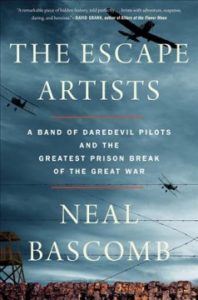 The Escape Artists: A Band of Daredevil Pilots & the Greatest Prison Break of the Great War: Neal Bascombe’s popular histories of the First World War are well-researched, thoughtful, and deeply engaging stories that make history feel real and vital. This book is no exception, delving into the world of POW camps during the First World War. For Allied soldiers, one of the worst camps was Holzminden, a land-locked prison that housed the most troublesome, escape-prone prisoners. Its commandant was a boorish, hate-filled tyrant named Karl Niemeyer who swore that none should ever leave. Desperate to break out of “Hellminden” and return to the fight, a group of Allied prisoners led by ace pilot (and former Army sapper) David Gray hatch an elaborate escape plan. Their plot demands a risky feat of engineering as well as a bevy of disguises, forged documents, fake walls, and steely resolve. Once beyond the watch towers and round-the-clock patrols, Gray and almost a dozen of his half-starved fellow prisoners must then make a heroic 150 mile dash through enemy-occupied territory towards free Holland. Bascombe’s work is based on letters, diaries, and other first-hand accounts of this sensational escape that is earned a starred review from Kirkus Reviews who called it “Fast-paced account of a forgotten episode of World War I history . . . Stirring . . . Bascomb’s portraits of the principals are affecting . . . Expertly narrated, with just the right level of detail and drama.”
The Escape Artists: A Band of Daredevil Pilots & the Greatest Prison Break of the Great War: Neal Bascombe’s popular histories of the First World War are well-researched, thoughtful, and deeply engaging stories that make history feel real and vital. This book is no exception, delving into the world of POW camps during the First World War. For Allied soldiers, one of the worst camps was Holzminden, a land-locked prison that housed the most troublesome, escape-prone prisoners. Its commandant was a boorish, hate-filled tyrant named Karl Niemeyer who swore that none should ever leave. Desperate to break out of “Hellminden” and return to the fight, a group of Allied prisoners led by ace pilot (and former Army sapper) David Gray hatch an elaborate escape plan. Their plot demands a risky feat of engineering as well as a bevy of disguises, forged documents, fake walls, and steely resolve. Once beyond the watch towers and round-the-clock patrols, Gray and almost a dozen of his half-starved fellow prisoners must then make a heroic 150 mile dash through enemy-occupied territory towards free Holland. Bascombe’s work is based on letters, diaries, and other first-hand accounts of this sensational escape that is earned a starred review from Kirkus Reviews who called it “Fast-paced account of a forgotten episode of World War I history . . . Stirring . . . Bascomb’s portraits of the principals are affecting . . . Expertly narrated, with just the right level of detail and drama.”
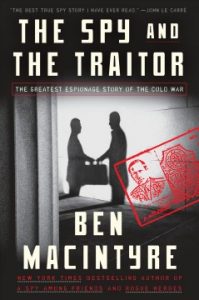 The Spy and the Traitor: The Greatest Espionage Story of the Cold War: Those of you looking for some more sensational war stories will love this latest from Ben Macintyre, whose work on espionage history has resulted in some highly entertaining real-life spy stories. This book tells the story of Oleg Gordievsky, who took his first posting for Russian intelligence in 1968 and eventually became the Soviet Union’s top man in London. However, Gordievsky was also a double agent, and from 1973, was secretly working for Britain’s MI6. For nearly a decade, as the Cold War reached its twilight, Gordievsky helped the West turn the tables on the KGB, exposing Russian spies and helping to foil countless intelligence plots, as the Soviet leadership grew increasingly paranoid. Desperate to keep the circle of trust close, MI6 never revealed Gordievsky’s name to its counterparts in the CIA, which in turn grew obsessed with figuring out the identity of Britain’s obviously top-level source. Their obsession ultimately doomed Gordievsky: the CIA officer assigned to identify him was none other than Aldrich Ames, the man who would become infamous for secretly spying for the Soviets. Culminating in the gripping cinematic beat-by-beat of Gordievsky’s nail-biting escape from Moscow in 1985, this is a history book that fans of many genres will savor. The Guardian wrote a glowing review of the book, noting “Macintrye had no access to MI6’s archives, which remain secret. But he has interviewed all of the former officers involved in the case, who tell their stories for the first time. He spoke extensively to Gordievsky, who is now 79 and living in the home counties – a remarkable figure, “proud, shrewd and irascible”. The result is a dazzling non-fiction thriller and an intimate portrait of high-stakes espionage.”
The Spy and the Traitor: The Greatest Espionage Story of the Cold War: Those of you looking for some more sensational war stories will love this latest from Ben Macintyre, whose work on espionage history has resulted in some highly entertaining real-life spy stories. This book tells the story of Oleg Gordievsky, who took his first posting for Russian intelligence in 1968 and eventually became the Soviet Union’s top man in London. However, Gordievsky was also a double agent, and from 1973, was secretly working for Britain’s MI6. For nearly a decade, as the Cold War reached its twilight, Gordievsky helped the West turn the tables on the KGB, exposing Russian spies and helping to foil countless intelligence plots, as the Soviet leadership grew increasingly paranoid. Desperate to keep the circle of trust close, MI6 never revealed Gordievsky’s name to its counterparts in the CIA, which in turn grew obsessed with figuring out the identity of Britain’s obviously top-level source. Their obsession ultimately doomed Gordievsky: the CIA officer assigned to identify him was none other than Aldrich Ames, the man who would become infamous for secretly spying for the Soviets. Culminating in the gripping cinematic beat-by-beat of Gordievsky’s nail-biting escape from Moscow in 1985, this is a history book that fans of many genres will savor. The Guardian wrote a glowing review of the book, noting “Macintrye had no access to MI6’s archives, which remain secret. But he has interviewed all of the former officers involved in the case, who tell their stories for the first time. He spoke extensively to Gordievsky, who is now 79 and living in the home counties – a remarkable figure, “proud, shrewd and irascible”. The result is a dazzling non-fiction thriller and an intimate portrait of high-stakes espionage.”
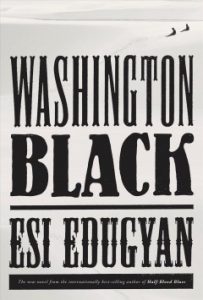 Washington Black: Shortlisted for the Man Booker Prize yesterday, Esi Edugyan’s novel tells the story of George Washington Black, or “Wash,” an eleven-year-old field slave on a Barbados sugar plantation. Although initially terrified to be chosen by his master’s brother as his manservant, Wash is surprised to learn the eccentric Christopher Wilde is a naturalist, explorer, inventor, and abolitionist. Soon Wash is initiated into a world where a flying machine can carry a man across the sky, where even a boy born in chains may embrace a life of dignity and meaning–and where two people, separated by an impossible divide, can begin to see each other as human. But when a man is killed and a bounty is placed on Wash’s head, Christopher and Wash must abandon everything, escaping along the eastern coast of America, and, finally, to a remote outpost in the Arctic. What brings Christopher and Wash together will tear them apart, propelling Wash even further across the globe in search of his true self. This is a novel about freedom and friendship that is as thought-provoking as it is wonderfully imaginative. Publisher’s Weekly gave it a starred (and boxed!) review, raving that “Edugyan’s magnificent third novel again demonstrates her range and gifts . . . Framing the story with rich evocations of the era’s science and the world it studies, Edugyan mines the tensions between individual goodwill and systemic oppression, belonging and exclusion, wonder and terror, and human and natural order . . . Crafted in supple, nuanced prose, Edugyan’s novel is both searing and beautiful.”
Washington Black: Shortlisted for the Man Booker Prize yesterday, Esi Edugyan’s novel tells the story of George Washington Black, or “Wash,” an eleven-year-old field slave on a Barbados sugar plantation. Although initially terrified to be chosen by his master’s brother as his manservant, Wash is surprised to learn the eccentric Christopher Wilde is a naturalist, explorer, inventor, and abolitionist. Soon Wash is initiated into a world where a flying machine can carry a man across the sky, where even a boy born in chains may embrace a life of dignity and meaning–and where two people, separated by an impossible divide, can begin to see each other as human. But when a man is killed and a bounty is placed on Wash’s head, Christopher and Wash must abandon everything, escaping along the eastern coast of America, and, finally, to a remote outpost in the Arctic. What brings Christopher and Wash together will tear them apart, propelling Wash even further across the globe in search of his true self. This is a novel about freedom and friendship that is as thought-provoking as it is wonderfully imaginative. Publisher’s Weekly gave it a starred (and boxed!) review, raving that “Edugyan’s magnificent third novel again demonstrates her range and gifts . . . Framing the story with rich evocations of the era’s science and the world it studies, Edugyan mines the tensions between individual goodwill and systemic oppression, belonging and exclusion, wonder and terror, and human and natural order . . . Crafted in supple, nuanced prose, Edugyan’s novel is both searing and beautiful.”
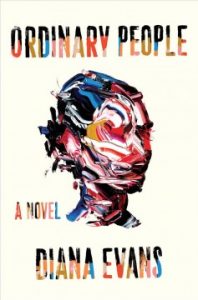 Ordinary People: Diana Evans is known for confronting difficult topics in her books with indefatigable humanity, and this novel is no exception, capturing the struggles of two married couples. In a crooked house in South London, Melissa feels increasingly that she’s defined solely by motherhood, while Michael mourns the former thrill of their romance. In the suburbs, Stephanie’s aspirations for bliss on the commuter belt, coupled with her white middle-class upbringing, compound Damian’s itch for a bigger life catalyzed by the death of his activist father. Longtime friends from the years when passion seemed permanent, the couples have stayed in touch, gathering for births and anniversaries, bonding over discussions of politics, race, and art. But as bonds fray, the lines once clearly marked by wedding bands aren’t so simply defined. Evans is the kind of writing who can make everyday details feel extraordinary, and that talent makes this story about the fragile bonds that bind us together so moving. Library Journal had a world of good things to say about this class, noting “This new novel from Evans…tells the story of a group of young, mostly black Londoners searching for equanimity in their personal and professional lives, with the music of John Legend, Jill Scott, and Amy Winehouse providing the soundtrack as they navigate the rocky roads from dating to mating and parenting…. With astute observations on marriage and parenthood… and an accompanying playlist to boot, this novel is anything but ordinary. It’s a sparkling gem.”
Ordinary People: Diana Evans is known for confronting difficult topics in her books with indefatigable humanity, and this novel is no exception, capturing the struggles of two married couples. In a crooked house in South London, Melissa feels increasingly that she’s defined solely by motherhood, while Michael mourns the former thrill of their romance. In the suburbs, Stephanie’s aspirations for bliss on the commuter belt, coupled with her white middle-class upbringing, compound Damian’s itch for a bigger life catalyzed by the death of his activist father. Longtime friends from the years when passion seemed permanent, the couples have stayed in touch, gathering for births and anniversaries, bonding over discussions of politics, race, and art. But as bonds fray, the lines once clearly marked by wedding bands aren’t so simply defined. Evans is the kind of writing who can make everyday details feel extraordinary, and that talent makes this story about the fragile bonds that bind us together so moving. Library Journal had a world of good things to say about this class, noting “This new novel from Evans…tells the story of a group of young, mostly black Londoners searching for equanimity in their personal and professional lives, with the music of John Legend, Jill Scott, and Amy Winehouse providing the soundtrack as they navigate the rocky roads from dating to mating and parenting…. With astute observations on marriage and parenthood… and an accompanying playlist to boot, this novel is anything but ordinary. It’s a sparkling gem.”
Until next week, beloved patrons–happy reading!
